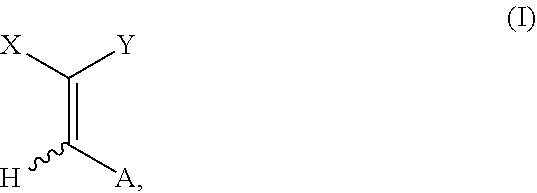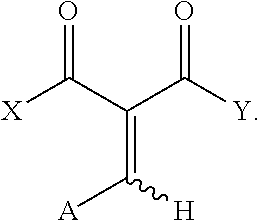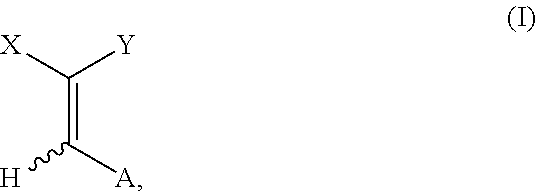Precursor compounds for fragrant aldehydes
a technology of precursor compounds and aldehydes, which is applied in the field of precursor compounds for fragrant aldehydes, can solve problems such as deactivation of precursor compounds, and achieve the effects of preventing or reducing the extent and/or rate of deactivation
- Summary
- Abstract
- Description
- Claims
- Application Information
AI Technical Summary
Benefits of technology
Problems solved by technology
Method used
Image
Examples
example 1
on of rac. ethyl 2-acetyl-4-methyltridec-2-enoate (III)
[0088]
[0089]Ethyl acetoacetate (239.8 g, 1.83 mol, 1.2 equiv.) and 2-methyl undecanal (“Aldehyde C12MNA”, 283.0 g, 1.52 mol, 1.0 equiv.) were placed in a 1.5 L glass reaction flask equipped with a mechanical stirrer and a distillation apparatus (15 cm Vigreux column) connected to a vacuum outlet. Piperidine (517 mg, 6.0 mmol, 0.4 mol %) was added and the mixture was stirred at 50° C. and ambient pressure for 1 h, after which time the mixture became turbid. Vacuum was applied (100 mbar) and stirring at 50° C. was continued for 24 h. The distillation receiver flask was cooled with an ice bath. A total of 59 g of distillate was recovered, containing water and ethyl acetoacetate. The apparatus was brought to ambient pressure and cooled to room temperature. The product (III) (426 g, 95%) was obtained as a clear, pale yellow oil exhibiting an aldehydic fruity-orange scent. The product was composed of 36% (E)-2-acetyl-4-methyltridec-2-...
example 2
on of pure Z- and E-Isomers of rac. ethyl 2-acetyl-4-methyltridec-2-enoate (III)
[0090]
[0091]Pure E- and Z-isomers of ethyl 2-acetyl-4-methyltridec-2-enoate (III) were obtained by silica gel column chromatography of 25 g of the crude product obtained from the condensation of ethyl acetoacetate and 2-methyl undecanal as described in Example 1 with hexane / MTBE 4:1 as eluent.
[0092]From this, 4.3 g (17%) of pure ethyl (Z)-2-acetyl-4-methyltridec-2-enoate Z-(III) was obtained and 3.2 g (13%) of 95% pure ethyl (E)-2-acetyl-4-methyltridec-2-enoate E-(III), which was further purified by a second silica gel column chromatography with hexane / MTBE 9:1 to obtain 2.5 g of pure ethyl (E)-2-acetyl-4-methyltridec-2-enoate E-(III). Both products were colourless oils exhibiting an aldehydic fruity-orange scent.
[0093]Ethyl (E)-2-acetyl-4-methyltridec-2-enoate E-(III):
[0094]Rf (hexane / MTBE 4.1)=0.60
[0095]1H-NMR (400 MHz, C6D6) 6.75 (d, J=10.8 Hz, 1H), 3.93 (q, J=7.1 Hz, 2H), 2.45-2.61 (m, 1H), 2.21 (s, ...
example 3
on of ethyl 2-acetyl-4-methyltridec-3-enoate (IV)
[0099]
[0100]Ethyl 2-acetyl-4-methyltridec-3-enoate (III) was obtained by repeated chromatographic purification of a sample (9.0 g) of the crude product obtained from the condensation of ethyl acetoacetate and 2-methyl undecanal as described in Example 1, which had been stored in a closed bottle at 50° C. for 1 month. The sample was first chromatographed over SiO2 with hexane / MTBE 4:1 to afford ca. 3 g of a light yellow oil. This material was then chromatographed over A103 with hexane / MtBE 4:1 to give 1.2 g of a colorless and virtually odourless liquid. The NMR-spectra reveal the presence of a 57:43 mixture of enol and keto forms, both as E- / Z-mixtures.
[0101]1H-NMR (400 MHz, C6D6; mixture of enol and keto forms as described above) 13.48 (q, J=0.7 Hz, 0.4H), 13.46 (q, J=0.7 Hz, 0.2H), 5.78 (br. s, J=0.7 Hz, 0.5H), 5.62-5.73 (series of m, 0.8H), 4.35 (d, J=9.8 Hz, 0.2H), 4.26 (d, J=9.3 Hz, 0.2H), 3.90-4.02 (series of m, 2H), 1.87 2.06 (s...
PUM
| Property | Measurement | Unit |
|---|---|---|
| Temperature | aaaaa | aaaaa |
| Fraction | aaaaa | aaaaa |
| Fraction | aaaaa | aaaaa |
Abstract
Description
Claims
Application Information
 Login to View More
Login to View More - R&D
- Intellectual Property
- Life Sciences
- Materials
- Tech Scout
- Unparalleled Data Quality
- Higher Quality Content
- 60% Fewer Hallucinations
Browse by: Latest US Patents, China's latest patents, Technical Efficacy Thesaurus, Application Domain, Technology Topic, Popular Technical Reports.
© 2025 PatSnap. All rights reserved.Legal|Privacy policy|Modern Slavery Act Transparency Statement|Sitemap|About US| Contact US: help@patsnap.com



